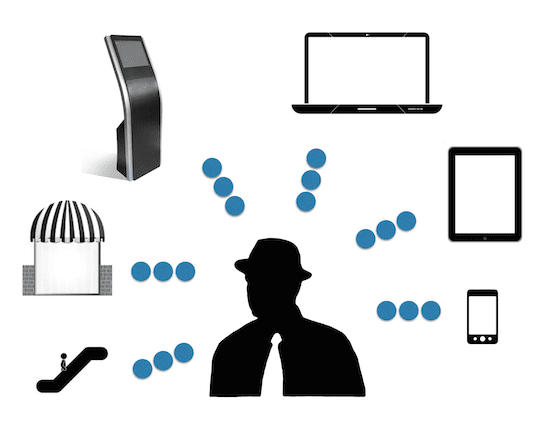During a recent shopping spree in Madrid, I decided to buy myself a new outfit. I chose a well-known high-end brand with latin roots. The experience was decidedly mitigated and decries the difficulty in crafting an upscale and luxury strategy in today’s multi or omnichannel world. For the purpose of this post, I have decided not to cite the name of the brand; but, if you know Madrid well, you can probably figure out the name of the brand in question. Where did they go wrong?
Distribution strategy
This particular upscale brand, catering to men and women, has a distinctive style that appeals to me. It has an elegant flagship store on Calle Serrano in Madrid. Besides a handful of proprietary stores throughout Madrid, they also sell their clothing at the omnipresent department store, El Corte Inglés.
The equilibrium between opportunity and threat that wholesalers represent for brands has been playing out for many decades. For the luxury brands, the question is distinctly more treacherous. To control or not to control one’s customer experience end to end? As for so many big name brands, somewhere along the line, the department stores with the dominant market share become ineluctably part of the distribution mix. It’s a common story for brands, even for those who start with their own stores. They build a strong independent business. The brand name becomes well known. They open up more stores. Growth continues until it hits a stumbling block. The residing CEO, at some point, yields to the pressure for short-term gains and opens up the faucets by listing at stores where the image cannot be matched in accordance with the brand’s values. Thus begins a fateful struggle.
Achieving alignment
El Corte Inglés is undoubtedly the dominant department store in Spain. It lodges many of the premium brands and sells, for example, accessories and/or toiletries of luxury fashion brands. To its credit, it has a rather active marketing department that is trying out all sorts of experiments in order to stimulate its clientele. Recently, El Corte Inglés introduced a special “fidelity card” for tourists with a 10% voucher on all purchases that can be applied within three days against further purchases of over 50 euros. Is this a good deal for any of the luxury brands inside? Luxury and discount certainly do not go hand in hand — even 10%. Whether or not this should be considered as a discount, per se, the card is being promoted by the sales personnel as such. Secondly, without considering the challenges of an omnichannel distribution, an upscale brand must protect its added value positioning by having a consistent instore experience. However, the environment in El Corte Inglés — like in virtually any department store — is far from the flagship store experience. A brand like Loewe does not sell anything other than fragrances in El Corte Inglés and, I might argue, with good reason. So, the big conundrum is: If one doesn’t achieve alignment in physical stores, how can one expect to navigate successfully the omnichannel experience?
Where distribution mis-alignment can seriously trip up a brand is when the different locations start competing against one another. In this case, there was evident competition between El Corte Inglés and its “partner” brand. As a customer who had made a specific trip to this flagship store, I could sense the tension among the store personnel. There was an obvious reticence to let the “sale” slip into the hands of El Corte Ingles. The staff would go off and apparently call El Corte Ingles to find out about what they had available. Throughout, I felt like I was being yanked around by the instore staff. As a direct consequence, the customer experience was poor.
As it turns out, despite the sub-optimal experience, I ended up buying a suit at the flagship store on the belief that the same suit was not available at El Corte Inglés. Needless to say I later found out that the suit was stocked at the department store. Had I purchased the suit at the department store, I would have received a 10% voucher — not an inconsiderable amount in this case. From a customer standpoint, this leaves a bad taste in the mouth.
Computer systems and data
Another quirk of the experience was that the brand’s ‘corner’ store in El Corte Inglés needed to input (scan) all the items twice. Once for El Corte Inglés system and the second time for its own systems. This double entry speaks volumes to the issue of customer data. It also should enable seamless inventory management between all the various outlets for this brand. It is my distinct impression that the question of computer systems will become evermore important as brands grapple with eCommerce and big data in this omnichannel world. {Tweet this}
How to make an upscale or luxury strategy endure?
It’s easier said than done to create distribution alignment for an established brand, especially with an omnipresent pressure on performance. However, there are some key considerations that a luxury or upscale brand must take into account, at the very least, in the physical stores where the product is on sale. The first point of call is on the brand to make sure that the brand has identifiable, differentiated and de facto values that are well maintained throughout the value chain. As for the channel strategy, here is a quick checklist:
- Does the brand consider a client is a client is a client, wherever he/she may be? {Tweet this!}
- How is information (customer data, inventory, promotions) shared throughout the channel?
- Are pricing mechanisms and mechanics shared and understood across all outlets in real time?
- How are returns managed between outlets?
- What identifiable value is being provided to the instore experience — ideally in line with the brand’s values — beyond that which one can find online? E.g. Does the instore staff serve an Italian espresso or a glass of champagne (as, for example, Loewe does)?
And one more thing: wifi please!
As a final note, I was quite shocked at how few stores in Madrid offered wifi*. At all the stores I entered on Calle Serrano, none had wifi. Same issue for the El Corte Inglés I entered. In an era where competition is intense for clients — presumably also for tourists — the offer of wifi (to avoid unscrupulously high roaming charges) would seem like a small price to pay in order to gain what would be, at least for now, a competitive edge. Moreover, for customers wishing to share an experience (e.g. on social media) or just to occupy bored kids, the offer of wifi could still be considered like a real bonus and an enhanced customer experience.
Do you agree that wifi can make for an improved customer experience? Your comments and reactions please!
*I wrote how the Thyssen Museum in Madrid promoted a number of mobile apps for an enhanced museum experience, yet didn’t offer free wifi — which would benefit foreign tourists, the likes of which are presumably frequent visitors.













Trackbacks/Pingbacks